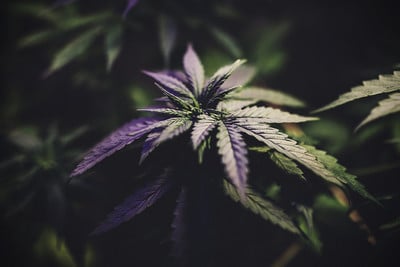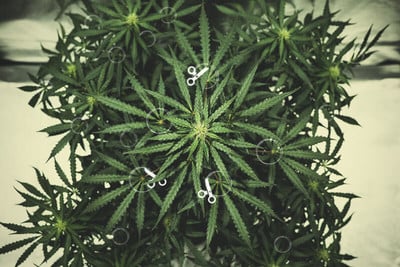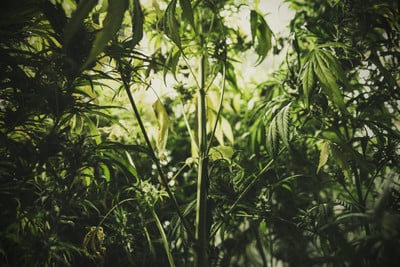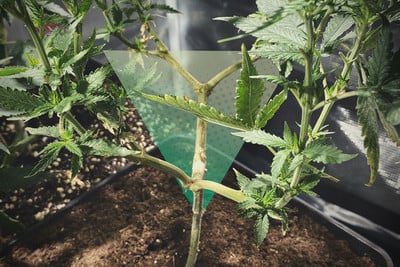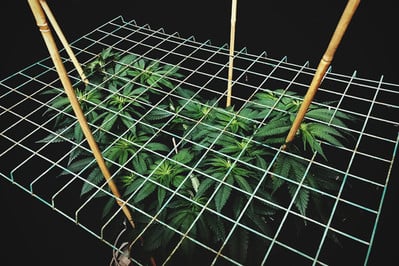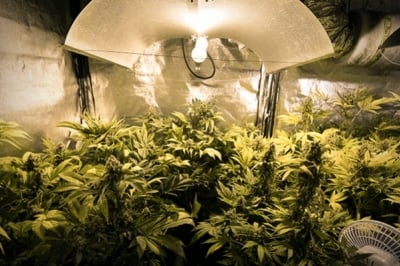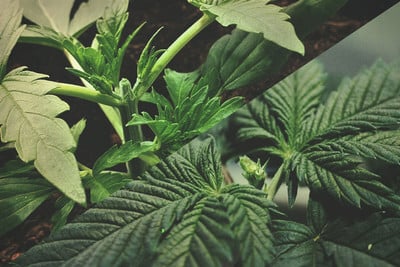 Cannabis Grow Guide by Royal Queen Seeds
Cannabis Grow Guide by Royal Queen Seeds
- Growing cannabis step by step
- Cannabis growing basics
- Choosing your seeds
- How to germinate seeds
- The cannabis vegetative stage
- The cannabis flowering stage
- Harvesting cannabis
- Trimming, drying, and curing
- Choosing pots and soil
-
Growing indoors
- A Complete Overview Of Growing Cannabis Indoors
- Cannabis Cultivation Tips: How To Set Up Indoor Grow Lights
- How Many Cannabis Plants Can You Grow Per Square Metre?
- Indoor Cannabis Growing: Relative Humidity and Temperatures
- Hydroponics Cannabis Growing Guide (with diagrams)
- Cannabis Micro Growing: Growing Great Weed in Tiny Spaces
- Growing outdoors
- How to grow autoflowering cannabis
- Cannabis nutrients and pH
- Cannabis troubleshooting: Nutrients
-
Cannabis troubleshooting: Growing
- Cannabis Seed Germination — Troubleshooting Guide
- How to Deal With Pythium (Root Rot) in Cannabis Plants
- Slow Cannabis Plant Growth And What You Can Do About It
- How to Prevent and Fix Stretching in Cannabis Seedlings
- Watering Your Cannabis: How to Fix Overwatering and Underwatering
- Understanding Male, Female, And Hermaphrodite Cannabis
- Identifying and Treating Common Cannabis Ailments
- How To Revive a Sick Cannabis Plant
- How to Avoid Mouldy Weed During Drying and Curing
- How to Prevent and Treat Dry and Crispy Cannabis Leaves
- What Cannabis Leaves Can Tell You
- Causes and Solutions for Yellow Cannabis Leaves
-
Cannabis Strains Grow Report
- HulkBerry Automatic Grow Report
- Blue Cheese Auto Grow Report
- Purple Punch Automatic Grow Report
- Triple G Automatic Grow Report
- Do-Si-Dos Automatic Grow Report
- Green Gelato Automatic Grow Report
- Haze Berry Automatic Grow Report
- Purple Queen Automatic Grow Report
- Cookies Gelato Automatic Grow Report
- Sherbet Queen Automatic Grow Report
- Sweet Skunk Automatic Grow Report
- Medusa F1 Grow Report
- Cannabis plant training
-
Weed growing tips
- The Cannabis Plant Anatomy
- How to preserve seeds
- How Much Sunlight Do Outdoor Cannabis Plants Need To Grow?
- How to Control and Prevent Stretching in Cannabis Plants
- My Cannabis Plants Are Growing Too Tall: What Should I Do?
- Should You Worry About Purple Or Red Cannabis Stems?
- What To Do When Your Indoor Cannabis Won’t Flower
- How To Protect Your Cannabis Plants From Heat Stress
- How To Tell If Your Female Cannabis Plant Has Been Pollinated
- Growing Medical Marijuana
- Bud Washing: How to Clean Your Weed
- Understanding Cannabis Yield per Plant

My Cannabis Plants Are Growing Too Tall: What Should I Do?
Contents:
- Why should you stop a cannabis plant from growing too tall?
- Why is my cannabis plant growing tall and skinny?
- How to control a cannabis plant’s height in the vegetative stage
- How to control height in the flowering stage
- Too-tall cannabis plants: learn from your mistakes
- Important considerations for tall cannabis plants indoors
Is your cannabis plant too tall? Stretchy, spindly plants can be a nuisance for a lot of reasons. From falling over to burning themselves on your lighting rig, plants with uncontrolled growth are not desirable.
And a taller plant does not necessarily mean a bigger harvest. In fact, tall cannabis plants can be a sign that they are unhappy—particularly, that they do not have enough light. As well as causing your plants to stretch, a lack of light will negatively impact the size and quality of your final crop.
So, how do you stop weed plants from growing too tall? There are many options at your disposal, and some will help to increase your yield too!
Why Should You Stop a Cannabis Plant From Growing Too Tall?
There are a lot of good reasons to stop cannabis plants from growing too tall. Whether it’s to maximise the potential of a grow space or to keep the grow hidden, you need to ensure your plants don’t grow uninhibited.
Here are some reasons to rein in a marijuana plant’s growth:
| Privacy and security | Big plants will attract more attention—both through size and smell. |
| Flowering stretch | Some plants can double in size during the early flowering stage. If you haven't prepared for this, you might discover you don’t have enough room in your grow space. |
| Equal light distribution | Taller plants will get a lot of light at the canopy, but very little near the base. This means that the lower buds will hardly develop, reducing your yield potential. |
| Get light to smaller plants | If you’re growing multiple strains, some will be smaller than others. Unless you control the height of the taller ones, they will stop the smaller plants from getting enough light. |
| Prevent light burn | If your plants grow too tall and get too close to the lights, they will burn. This can hamper overall growth and will ruin the main colas at the top. |
| Privacy and security |
|
Big plants will attract more attention—both through size and smell. |
| Flowering stretch |
|
Some plants can double in size during the early flowering stage. If you haven't prepared for this, you might discover you don’t have enough room in your grow space. |
| Equal light distribution |
|
Taller plants will get a lot of light at the canopy, but very little near the base. This means that the lower buds will hardly develop, reducing your yield potential. |
| Get light to smaller plants |
|
If you’re growing multiple strains, some will be smaller than others. Unless you control the height of the taller ones, they will stop the smaller plants from getting enough light. |
| Prevent light burn |
|
If your plants grow too tall and get too close to the lights, they will burn. This can hamper overall growth and will ruin the main colas at the top. |
Why Is My Cannabis Plant Growing Tall and Skinny?
If your weed plants are getting too tall, one of the first things to do is identify why it’s happening. Otherwise, you may use the wrong solution, which will negatively impact your grow.
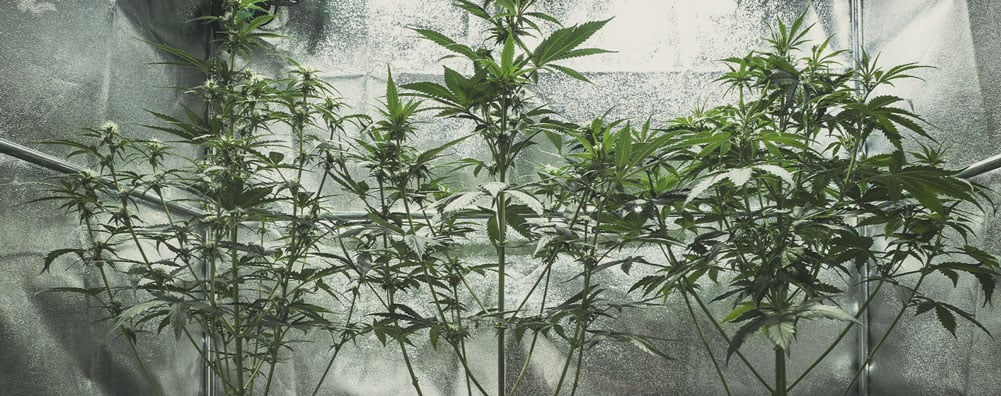
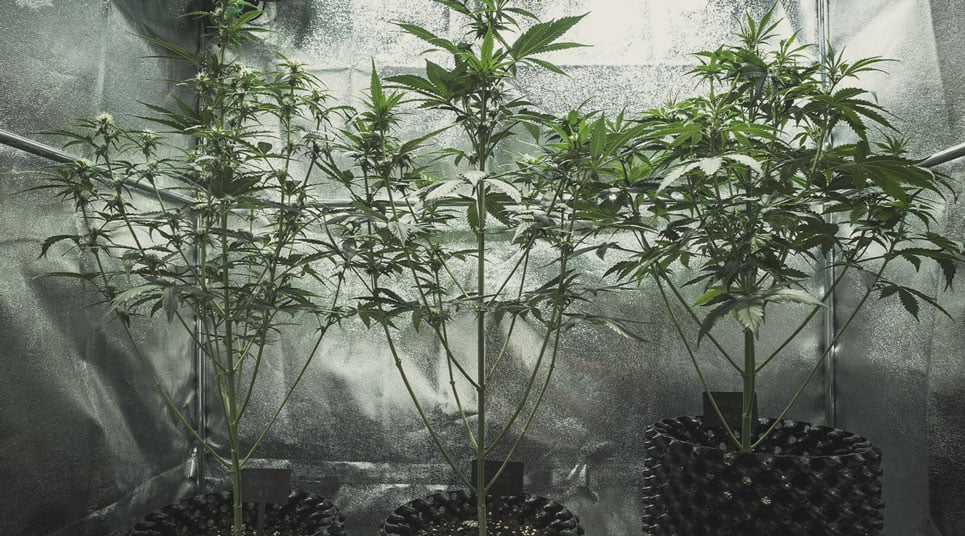
Reasons your weed plants might be getting too tall include:
| Incorrect light distance | If your lights are too far away from your plants, they will stretch in an attempt to get closer. This is a natural behaviour born of trying to grow above competing plant life. |
| Weak light | If your lights are just not strong enough, your plants will stretch up to them no matter how high or low they’re placed—they will hunt for light until they’re satisfied. |
| Red-dominant light spectrum | In nature, cannabis plants grow during the spring and summer. At these times, when the sunlight is at its strongest, plants are subject to blue and white light spectrums. During autumn, the sunlight weakens and enters a red spectrum. To give your plants ample photo-fuel, make sure you’re using the right light spectrum for the respective stage of development. |
| You’ve kept them vegging too long | Photoperiod cannabis plants kept in the vegetative stage will continue to grow. So if you veg them for too long and don’t control it, they will grow very large and unwieldy. |
| Genetics | Some strains of cannabis like to grow tall and spindly—for instance, landrace sativas. While these can be controlled, if you’re really limited for height, many indica varieties are more suitable. |
| Incorrect light distance |
|
If your lights are too far away from your plants, they will stretch in an attempt to get closer. This is a natural behaviour born of trying to grow above competing plant life. |
| Weak light |
|
If your lights are just not strong enough, your plants will stretch up to them no matter how high or low they’re placed—they will hunt for light until they’re satisfied. |
| Red-dominant light spectrum |
|
In nature, cannabis plants grow during the spring and summer. At these times, when the sunlight is at its strongest, plants are subject to blue and white light spectrums. During autumn, the sunlight weakens and enters a red spectrum. To give your plants ample photo-fuel, make sure you’re using the right light spectrum for the respective stage of development. |
| You’ve kept them vegging too long |
|
Photoperiod cannabis plants kept in the vegetative stage will continue to grow. So if you veg them for too long and don’t control it, they will grow very large and unwieldy. |
| Genetics |
|
Some strains of cannabis like to grow tall and spindly—for instance, landrace sativas. While these can be controlled, if you’re really limited for height, many indica varieties are more suitable. |
How To Control a Cannabis Plant’s Height in the Vegetative Stage
The vegetative stage is generally the best stage during which to rein in your plant’s growth. This is because you can afford to inflict damage on it, and it will recover before it starts flowering. During the flowering stage, however, damage may just lead to a reduced yield. So don’t wait to act!
-
Bending or Low-Stress Training
Low-stress training (LST) and bending are great methods to keep stretching under control. In fact, they’re just good practice. Not only will they keep plants lower to the ground, but they will increase light penetration to all of the bud sites, resulting in larger yields.
By tying the main stem down laterally, the side of the plant becomes the canopy. This provides a much greater overall surface area exposed to strong light. As such, bending both controls growth and allows for greater and more equal bud development across the whole plant.
It is a method best employed from fairly early on. For autoflower plants it is particularly good, as they don’t handle high-stress techniques well.
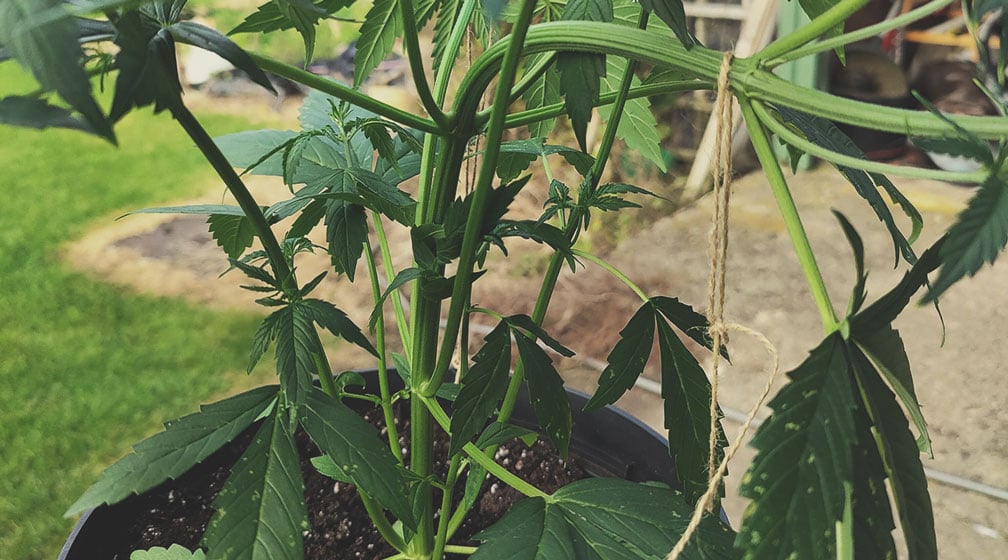
-
Topping
This is a more aggressive training method. Topping involves quite literally cutting the top of the plant off, where the main cola would begin to grow. By doing this, the plant recovers by growing not one but two new main colas. These tend to grow outward, rather than upward. So once again, not only do you control the plant’s height, but you get more bud too!
Just make sure you do this during the vegetative stage, otherwise you’ll just be chopping off your main bud!
Looking to keep your plants under control? Our Growing Guide provides simple tips for cannabis growth at every stage.
Free RQS
Grow Guide!

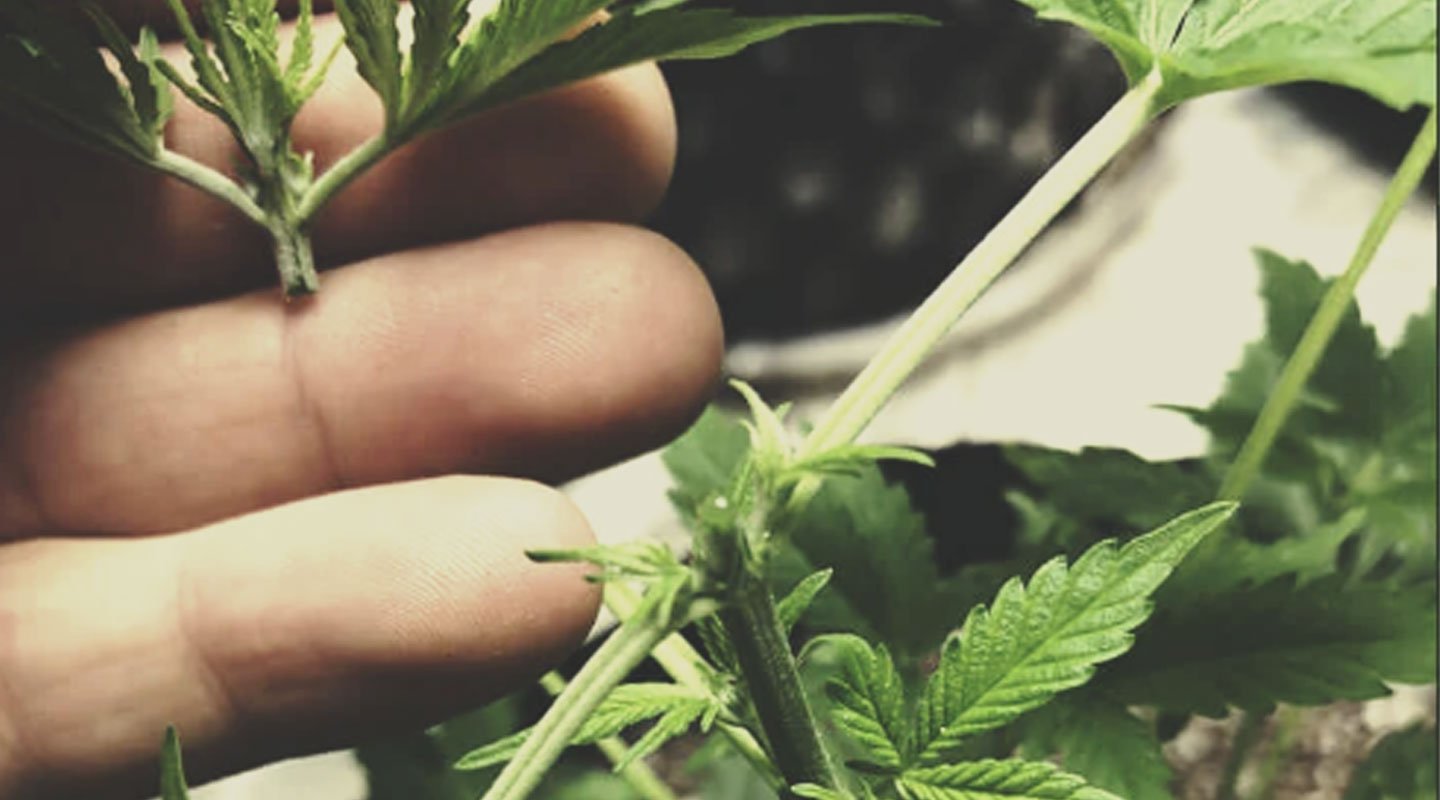
-
ScrOG
The screen of green (ScrOG) method involves growing your plants through a mesh screen and tying them down. Therefore, instead of growing upward, they begin to grow outward. Once again, this technique exposes the maximum surface area to light.
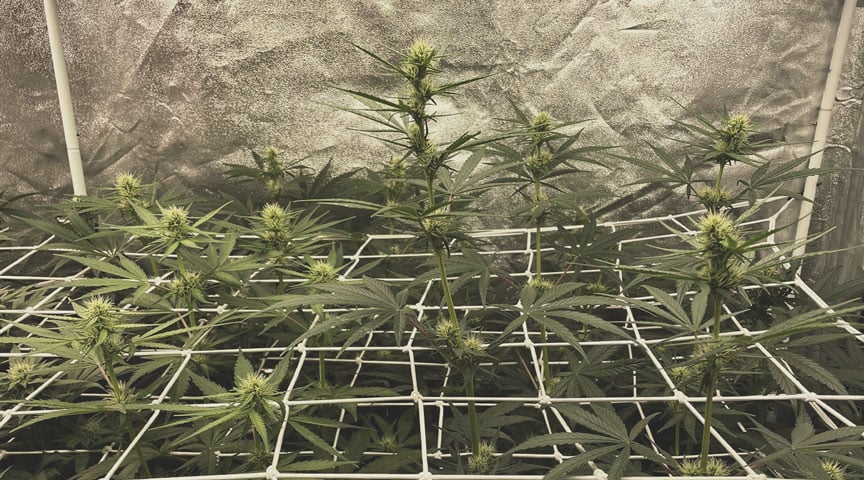
-
Pre-Flowering Topping
Letting your plants grow untouched during the vegetative phase, then topping just prior to flowering also controls height. When your plants are about to enter the flowering stage, top all branches. This has the effect of reining in the flowering stretch; instead of focusing energy on stretching out, the plants are urged to produce new flower growth.
Occasionally, pre-flower topping needs to be a full pre-flower pruning. If your plants fill the grow space during the vegetative phase, there is no way there will be enough room for flowering. It is time to get drastic. Aggressively prune the plants to half their size, and switch your lights to a 12/12 flower cycle.
Don’t worry, cannabis is very hardy and can even recover from being reduced to a stalk with only one or two leaves remaining. Try not to beat yourself up about the loss of time and reduced final yields. All lessons are good lessons on the way to becoming a weed growing expert.
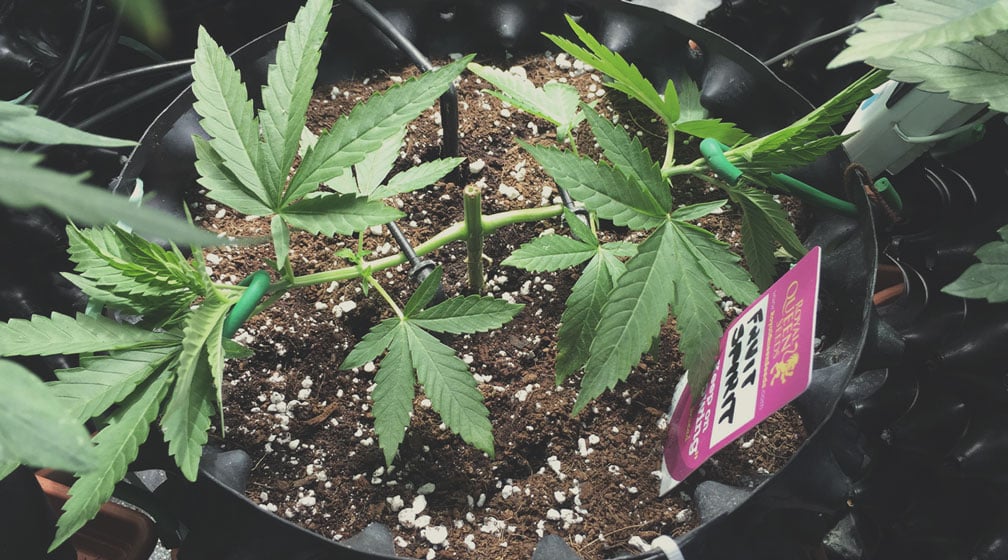
-
Move Tall Plants to the Edges
If it’s too late, and some of your plants have stretched, you might just want to move them to avoid light burn. The intensity of the light is strongest in the middle, and so by moving the plants to the side, they’ll be less likely to get burnt. Moreover, smaller plants will get more light, making them less likely to stretch.
One thing to be aware of, though, is that if the taller plants are already stretching, moving them out of the most intense light might just exacerbate the problem.
This can be done during either the vegetative or flowering stage.
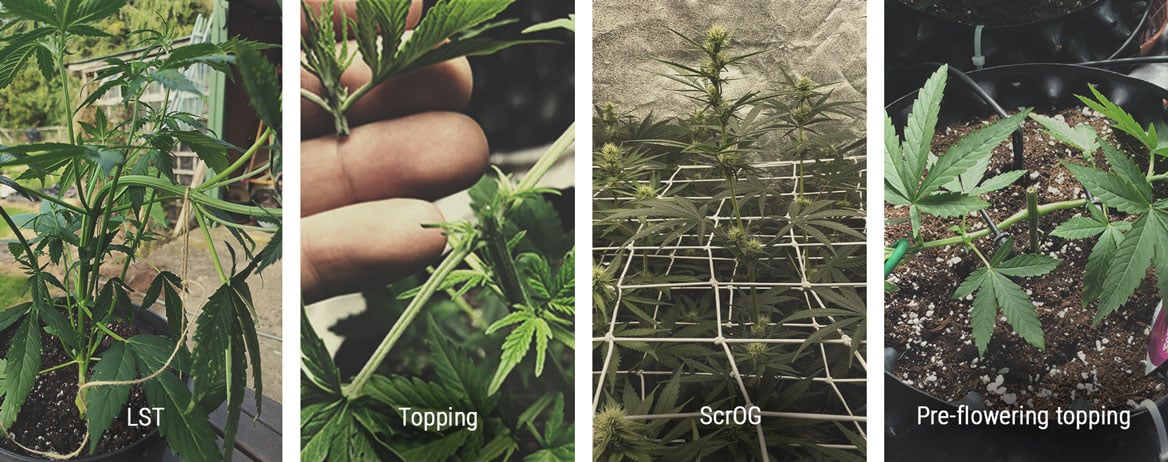

How To Control Height in the Flowering Stage
Ideally, you’ll notice that your cannabis plant is too tall during the vegetative stage, and you’ll do something about it then. But life is not always ideal! As mentioned, some strains can double in size during the early flowering stage, while others change nowhere near as much. If you’ve never grown a certain strain before, you may not know how predisposed to stretching during flowering it is. As a result, you might find your grow space suddenly overwhelmed and in need of a remedy.
-
Raise Grow Lights As High as Possible
At this stage your options are limited, and hopefully upward growth will soon come to an end. So with that in mind, one of your best options might be to move your lights higher and just try to avoid light burn. Plants will not stretch all the way through the flowering stage.
Depending on your grow space, though, this might not be possible.
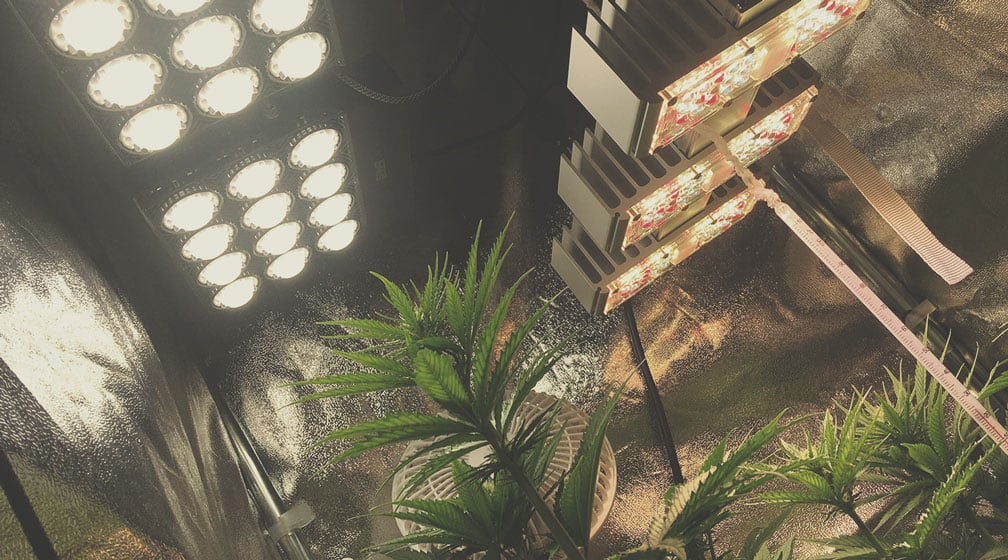
-
Reduce the Number of Light Hours per Day
Plants need light to grow (you probably know this). Therefore, reducing a plant’s supply of light will reduce its ability to grow. You don’t want to reduce it too much, as then you’ll just ruin your crop. But taking it down to 11 or even 10 hours a day should hopefully minimise stretching at this point.
-
Lollipop Your Plants
Lollipopping is one of the few training methods designed to be used during the flowering stage. Not only can it prevent your plant from growing too tall, but it will reduce humidity and the chance of mould, and it will hopefully increase your yield too. Just bear in mind that if you’re using it to control growth, it must be done prior to stretching. It cannot remedy it once it’s happened.
To lollipop, remove all the lower growth of the plant. Though you might think it’s all precious, the leaves and buds at the bottom will get next to no light, but will still take up the plant’s energy. In fact, cannabis plants will naturally shed lower leaves that are using more energy than they’re producing. This is just accelerating that process.
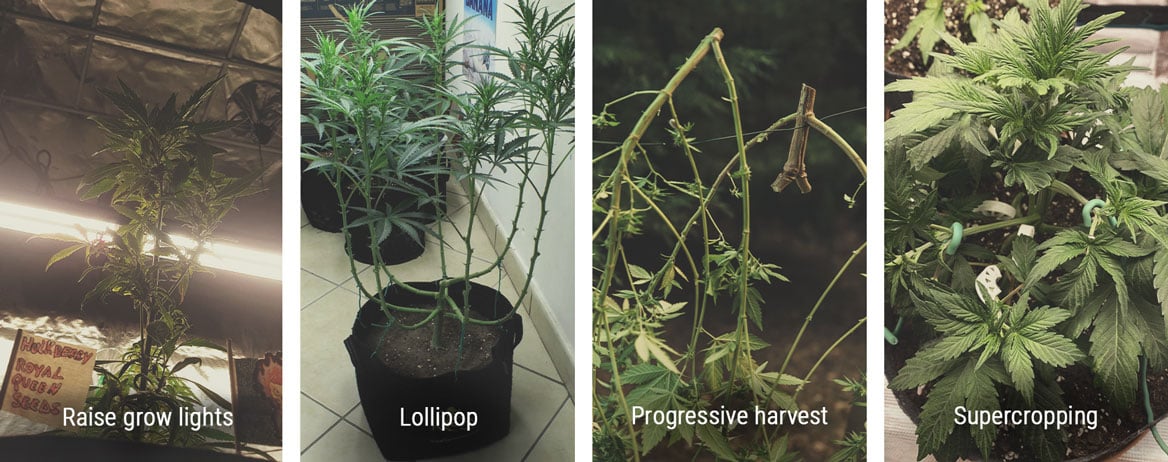

-
Progressive Harvest
If your plants are too tall and getting burnt, it’s best to harvest the upper buds as soon as possible. Once their trichomes start to turn milky, cut them off. It may not be ideal, but it’s probably the best option. By doing this, the lower colas will get more light and hopefully produce higher-quality buds.
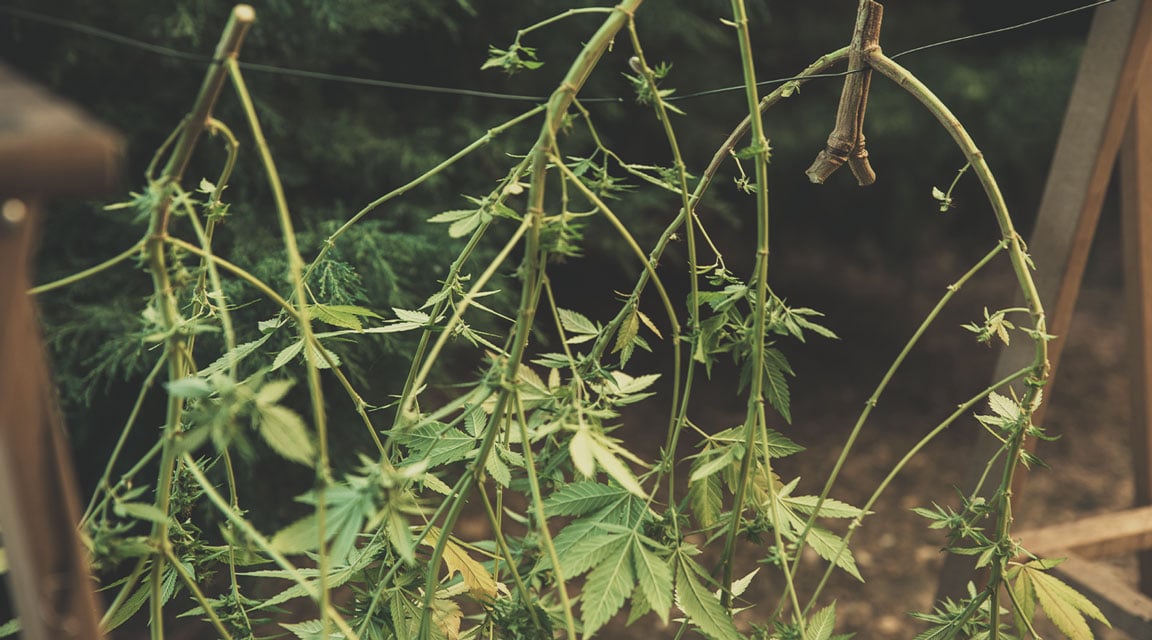
-
Turn Down Light Intensity
If you don’t have the option of moving your lights higher, and your plants have already stretched, one of the only options left may be to reduce the intensity of the lights to reduce light burn. If it gets to this stage, you may have to accept some burn or reduction in your yield.
But make an effort to balance the power reduction and the plants’ heights, and you should be able to come away fairly unscathed.
-
Supercropping During Flowering
This is a desperate measure that should only be enacted as a last possibility. It involves drastically bending the tallest branch of your plant, in the flowering phase.
Your plant will put energy on recover that part, so it can be detrimental overall.
However, if it gets to this stage, it’s about damage control. It’s likely that if you left them on, you’d fry your plant—so don’t get upset about what could not have been!
If you do this early enough, the lower branches and buds will grow taller and larger, and will hopefully go some way to make up for your loss.
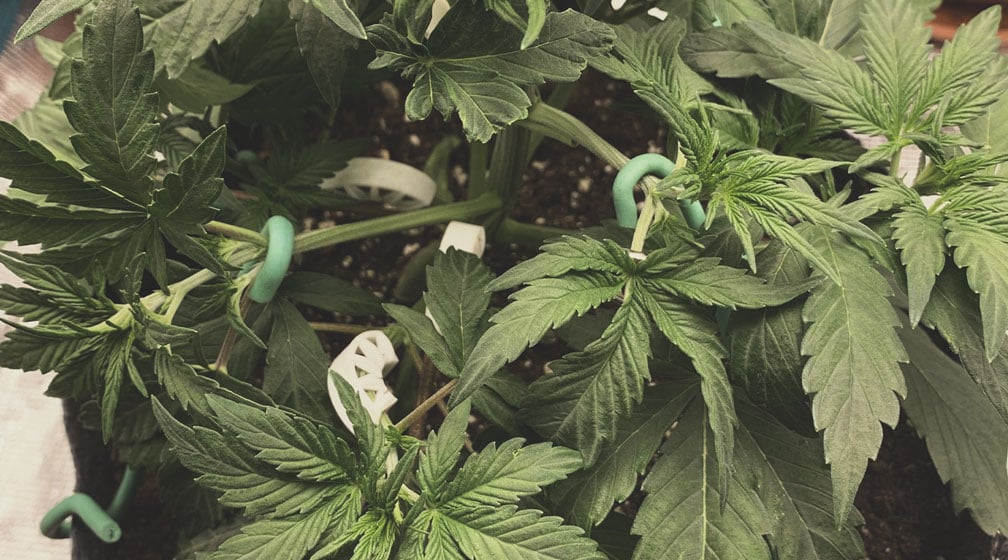
Too-Tall Cannabis Plants: Learn From Your Mistakes
Every grow is a huge learning experience, and so long as you take note of what went wrong, there’s no harm in failure. In fact, so long as we take heed, there’s no failure whatsoever. With that in mind, how can we prevent stretching and unnecessarily tall plants next time?
-
Use Smaller Pots
Pot size partially determines the maximum possible size of a plant. The bigger a plant grows, the bigger the root system will be. So if your last crop grew too tall, reduce the size of your containers next time—this should limit their growth. The best part about this option is that it doesn’t require intervention during the grow, and poses no threat to your plants’ health (so long as the pots aren’t extremely small).
-
Keep Grow Lights at the Optimal Distance
Keeping grow lights at the perfect distance from your crop will stop them from stretching, especially during the vegetative stage. You want them more or less as close as you can get them without risking light burn. Just make sure you move the lights higher as the plants grow!
-
Consider the Type of Light
Different types of light provide more or less power, and autumn into different spectrums. Using the right power and spectrum of light will encourage your plants to grow thick and strong rather than surge upward in search of light.
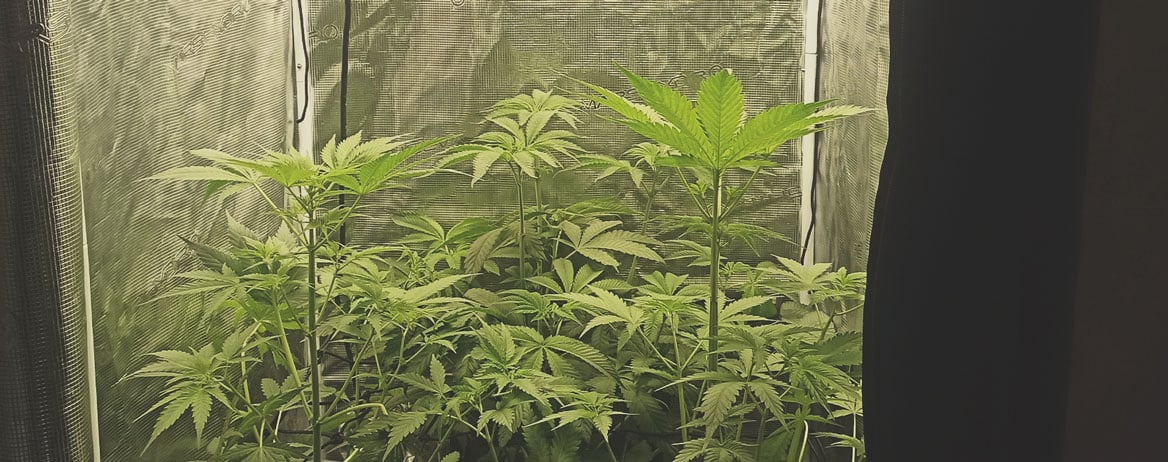
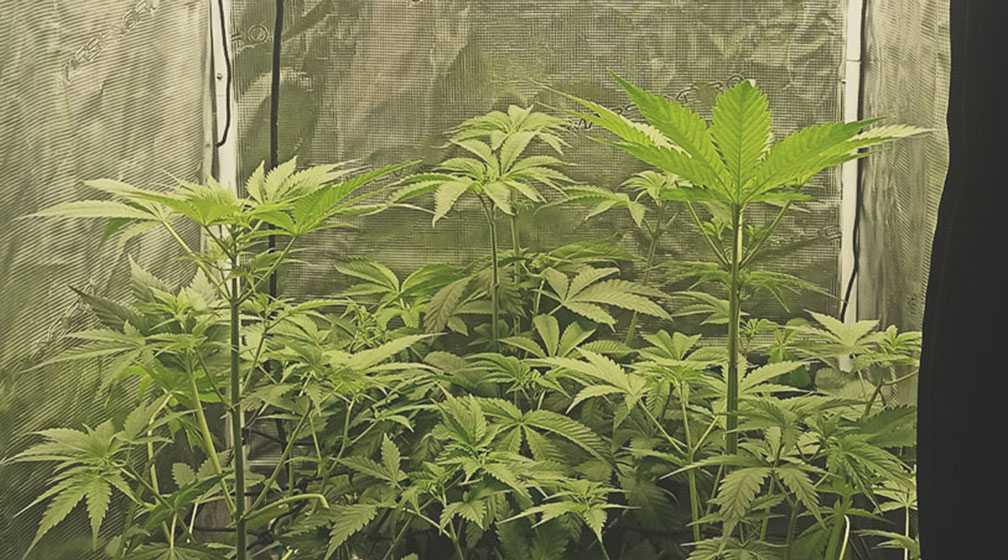
-
Research Your Strains
If you buy a commercial cannabis seed, or you know what strain you're growing, there will be information available about average heights—both indoors and out. This will tell you how tall a plant will get if grown in optimal conditions.
If a plant’s average height is looking like it might be pushing it for your grow, consider going for a smaller specimen to give some leeway in case of stretching. On the whole, indicas grow low and bushy, whereas sativas grow tall and spindly.
-
Don't Wait Too Long To Flower
As stated, the longer you veg the plant, the taller it will grow. So switch it at the right time. If it does get too big, top it, let it recover, and then switch it to flowering. You have a lot of room to play around while you’re still in the vegetative stage.
As plants can double their size during early flowering, look at the maximum height listed for the strain, and then switch to flowering when it’s half this size. It may well come in under this expectation, depending on the strain, but it’s unlikely to get much bigger than that.
-
Consider Growing in a Taller Grow Space
This is a luxury many simply don’t have. However, if your crop got too big for your grow space last time around, consider using a bigger space next time. Having more space won’t just allow for extra stretching, but will help with ventilation, making a healthy crop more likely.
Important Considerations for Tall Cannabis Plants Indoors
When plants get tall indoors, there are two major things to look out for.
-
Humidity
Cannabis transpires a substantial amount of water. Marijuana prefers a relative humidity (RH) of 50–65%. When they get too big, humidity can become a problem as the plants constantly release water vapor into the air. Water then gathers on leaves and other surfaces in the grow room, potentially causing mould and other issues.
If humidity is becoming a problem, a dehumidifier or increasing exhaust fan power can help. Defoliating can also increase airflow to control humidity. Remove lower and mid-level fan leaves only. This has the added benefit of increasing light penetration to the lower flowering branches.
-
Temperature
As with humidity, when plants get too big, temperature in the grow-op can rise. Reduced airflow and excessive height can drive up temperature and position plants too close to grow lights. Cannabis thrives when the temperature averages 25°C. When temps exceed this, plants are more likely to stretch. High temperatures can also affect leaf and flower formations, as well as final bud flavour and potency.
 Grow Guide Topic Finder
Grow Guide Topic Finder
- Growing cannabis step by step
- Cannabis growing basics
- Choosing your seeds
- How to germinate seeds
- The cannabis vegetative stage
- The cannabis flowering stage
- Harvesting cannabis
- Trimming, drying, and curing
- Choosing pots and soil
-
Growing indoors
- A Complete Overview Of Growing Cannabis Indoors
- Cannabis Cultivation Tips: How To Set Up Indoor Grow Lights
- How Many Cannabis Plants Can You Grow Per Square Metre?
- Indoor Cannabis Growing: Relative Humidity and Temperatures
- Hydroponics Cannabis Growing Guide (with diagrams)
- Cannabis Micro Growing: Growing Great Weed in Tiny Spaces
- Growing outdoors
- How to grow autoflowering cannabis
- Cannabis nutrients and pH
- Cannabis troubleshooting: Nutrients
-
Cannabis troubleshooting: Growing
- Cannabis Seed Germination — Troubleshooting Guide
- How to Deal With Pythium (Root Rot) in Cannabis Plants
- Slow Cannabis Plant Growth And What You Can Do About It
- How to Prevent and Fix Stretching in Cannabis Seedlings
- Watering Your Cannabis: How to Fix Overwatering and Underwatering
- Understanding Male, Female, And Hermaphrodite Cannabis
- Identifying and Treating Common Cannabis Ailments
- How To Revive a Sick Cannabis Plant
- How to Avoid Mouldy Weed During Drying and Curing
- How to Prevent and Treat Dry and Crispy Cannabis Leaves
- What Cannabis Leaves Can Tell You
- Causes and Solutions for Yellow Cannabis Leaves
-
Cannabis Strains Grow Report
- HulkBerry Automatic Grow Report
- Blue Cheese Auto Grow Report
- Purple Punch Automatic Grow Report
- Triple G Automatic Grow Report
- Do-Si-Dos Automatic Grow Report
- Green Gelato Automatic Grow Report
- Haze Berry Automatic Grow Report
- Purple Queen Automatic Grow Report
- Cookies Gelato Automatic Grow Report
- Sherbet Queen Automatic Grow Report
- Sweet Skunk Automatic Grow Report
- Medusa F1 Grow Report
- Cannabis plant training
-
Weed growing tips
- The Cannabis Plant Anatomy
- How to preserve seeds
- How Much Sunlight Do Outdoor Cannabis Plants Need To Grow?
- How to Control and Prevent Stretching in Cannabis Plants
- My Cannabis Plants Are Growing Too Tall: What Should I Do?
- Should You Worry About Purple Or Red Cannabis Stems?
- What To Do When Your Indoor Cannabis Won’t Flower
- How To Protect Your Cannabis Plants From Heat Stress
- How To Tell If Your Female Cannabis Plant Has Been Pollinated
- Growing Medical Marijuana
- Bud Washing: How to Clean Your Weed
- Understanding Cannabis Yield per Plant


























